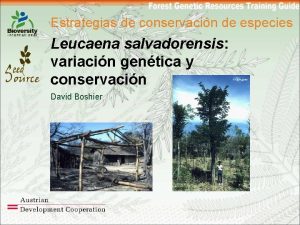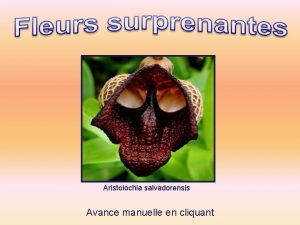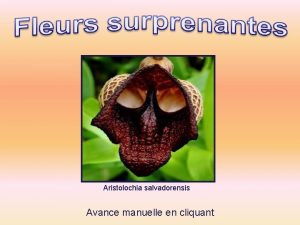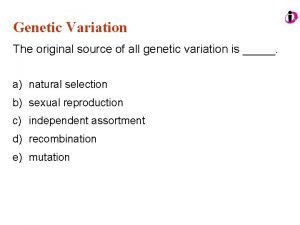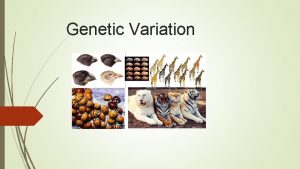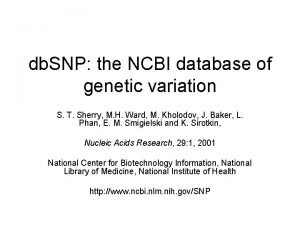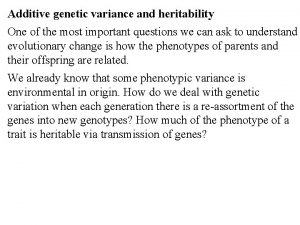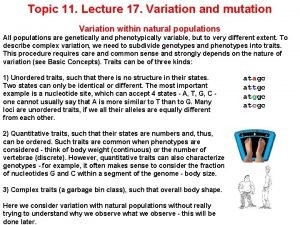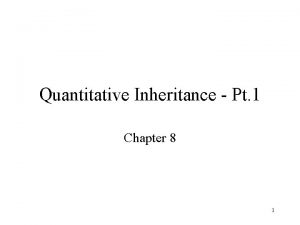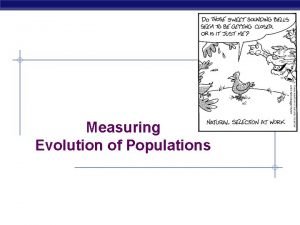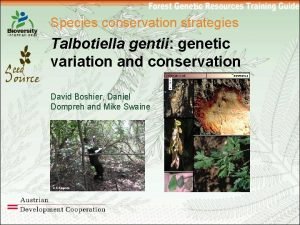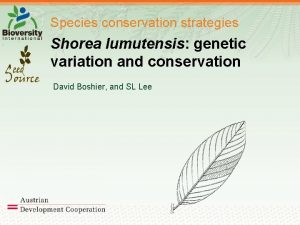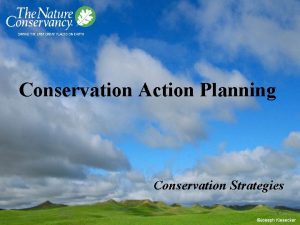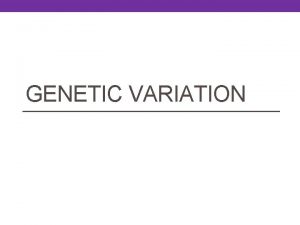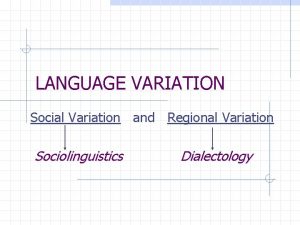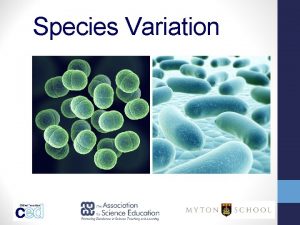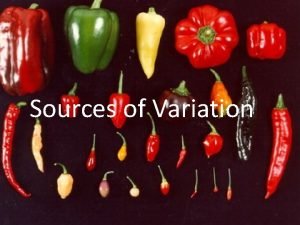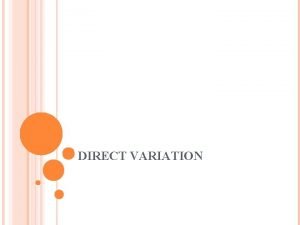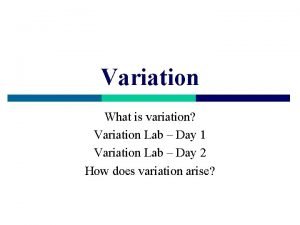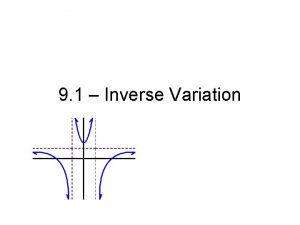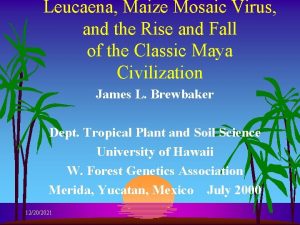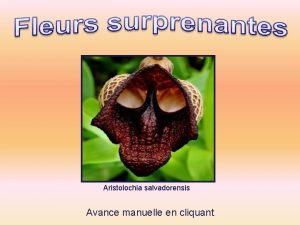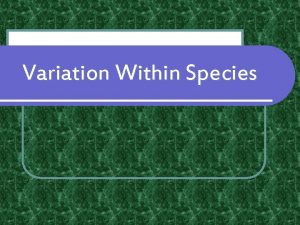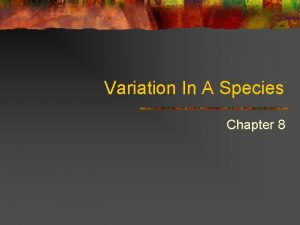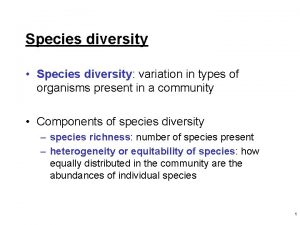Species conservation strategies Leucaena salvadorensis genetic variation and
























- Slides: 24

Species conservation strategies Leucaena salvadorensis: genetic variation and conservation David Boshier

© CE Hughes # trees in population No Population, Country 1 2 Nueva Esparta, El Salvador San Antonio, Honduras 16 224 3 Rio Nacaome, Honduras 120 4 La Garita, Honduras 500 5 La Galera, Honduras 181 6 Calaire, Honduras 700 7 Charco Verde, Honduras 8 San Juan Limay, Nicaragua 79 >1000 2

Nueva Esparta El Salvador © DH Boshier 3 © DH Boshier

Calaire Honduras 4 © DH Boshier

San Antonio Honduras © DH Boshier Rio Nacaome Honduras 5 © DH Boshier

6 © CE Hughes

L. leucocephala self compatible © CE Hughes L. salvadorensis self incompatible © CE Hughes 7

8

Conservation alternatives • preservation of actual diversity • conservation of evolutionary potential • mantain options for future generations, while satisfying present needs 9

10

How big is “big enough”? 50/500 rule (Franklin 1980) 50 - inbreeding depression to acceptable level 500 - sufficient for new variation from mutation to replace that lost by genetic drift refers to effective population size (Ne) rather than survey numbers (N) – so may need many more! in trees Ne smaller than N due to: overlapping generations, dioecy, asynchronous flowering, fecundity differences between individuals 11

Where should we conserve? In situ - Ex situ In situ - reserve system of undisturbed, protected areas within natural distribution (ecosystem based) Ex situ - artificial maintenance of populations outside natural distribution (species based) 12

Conservation of biodiversity in situ: trees as a paradigm ideal reserve model emphasis: large, continuous, protected areas limitations: location, size, security, biology: – – movement of animals extensive distribution of many species gene flow between populations upland, non agricultural areas essential but not sufficient 13

Conservation of biodiversity ex situ: methods and limitations seed banks - problems of regeneration plantations - changes in gene frequencies, few populations botanical gardens - deficiencies for gene pool conservation 14 © RBG Kew

Conservation of biodiversity ex situ: methods and limitations • useful, but resources limit application to few species (usually commercial) • last gasp holding for highly endangered species • complimentary to other approaches 15

© DH Boshier a large number of individuals of many species have long ago ceased being ecologically (and evolutionarily) reproductive; they flower but set no These are the deadnever lead to seed, or if they set seed, the living seedlings Janzen 1986 recruitment of adults. 16 © DH Boshier

Where should we conserve? • In situ - reserve system of undisturbed, protected areas within natural distribution (ecosystem based) • Ex situ - artificial maintenance of populations outside natural distribution (species based) • Circa situm - conservation within altered agricultural landscapes, within natural distribution 17

Conservation of biodiversity in practice: circa situm as a necessity? • Majority of conservation in situ outside of reserves emphasises: – trees outside of forests – role of indigenous/local communities – role of forest and land administrators – compatibility between resource management systems and conservation objectives 18

Conservation of alleles common - rare what proportion? widespread - localised what scale? common rare (<0. 05) widespread easy sample size localised key luck 19

Widespread vs locally common alleles Allele a b c d Pop 1 0. 500 0. 250 0. 230 0. 020 frequency 2 3 0. 320 0. 450 0. 030 0. 050 0. 400 0. 450 0. 250 0. 050 4 0. 550 0. 050 0. 350 0. 050 20

Figure 2. Genetic similarities (Nei unbiased genetic distance) between L. salvadorensis populations 21

Table 4. Gene flow (Nm - number of migrants per generation) below shaded boxes and geographic distance (in km) above shaded boxes between L. salvadorensis populations (details in Table 1). Correlation between gene flow and geographic distance: r = - 0. 17 Figure 3. Relationship between gene flow between populations (Nm – number of migrants per generation) and geographic distance (km); based on data from Table 4 22

Leucaena salvadorensis Conservation strategies – four groups El Salvador (country specific strategy) Honduras (country specific strategy) Nicaragua (country specific strategy) FAO (international perspective) 23

Leucaena salvadorensis each group summarize on wall chart paper or Power. Point Remember need a conservation objective prioritise actions – resources are limited list the localised but common alleles? list problems by type - genetic, which pops. too small? which are different? - other types of problems which conservation methods - in situ, ex situ, circa situm? who? will do, what? where? how will you pay for it? 24
 Leucaena salvadorensis
Leucaena salvadorensis Conservacin
Conservacin Concept mapping chapter 10 meiosis 1 and meiosis 2
Concept mapping chapter 10 meiosis 1 and meiosis 2 Aristolochia salvadorensis
Aristolochia salvadorensis Aristolochia salvadorensis
Aristolochia salvadorensis Founder effect vs gene flow
Founder effect vs gene flow Genetic programming vs genetic algorithm
Genetic programming vs genetic algorithm Genetic programming vs genetic algorithm
Genetic programming vs genetic algorithm Genetic drift
Genetic drift What is the difference between genetic drift and gene flow
What is the difference between genetic drift and gene flow The original source of all genetic variation is _____.
The original source of all genetic variation is _____. Genetic variation
Genetic variation Ecxed
Ecxed Db directo snp
Db directo snp Additive genetic variation definition
Additive genetic variation definition Genetic variation
Genetic variation Dominant genetic variance
Dominant genetic variance Keystone species plants
Keystone species plants What is ecosystem biodiversity
What is ecosystem biodiversity Ecosystem jigsaw activity
Ecosystem jigsaw activity Direct variation equation
Direct variation equation Direct and inverse variation graphs
Direct and inverse variation graphs Correlation and regression
Correlation and regression Stores and transmits genetic (hereditary) information
Stores and transmits genetic (hereditary) information What is gene flow and genetic drift
What is gene flow and genetic drift

